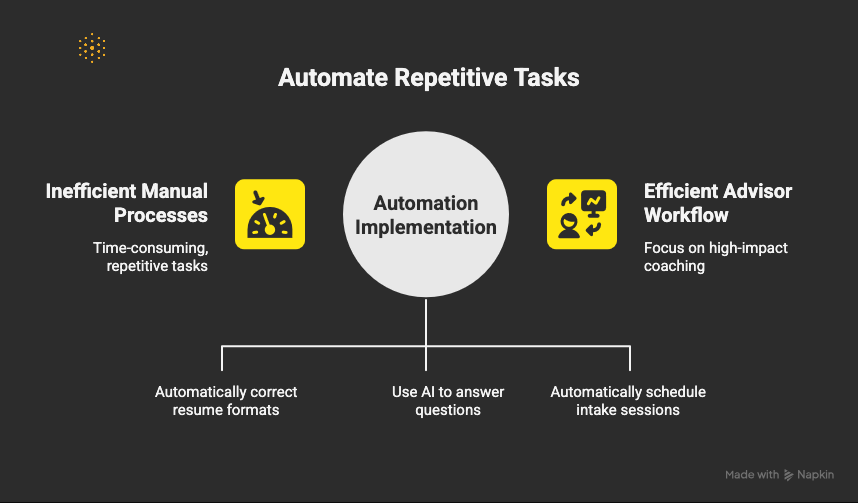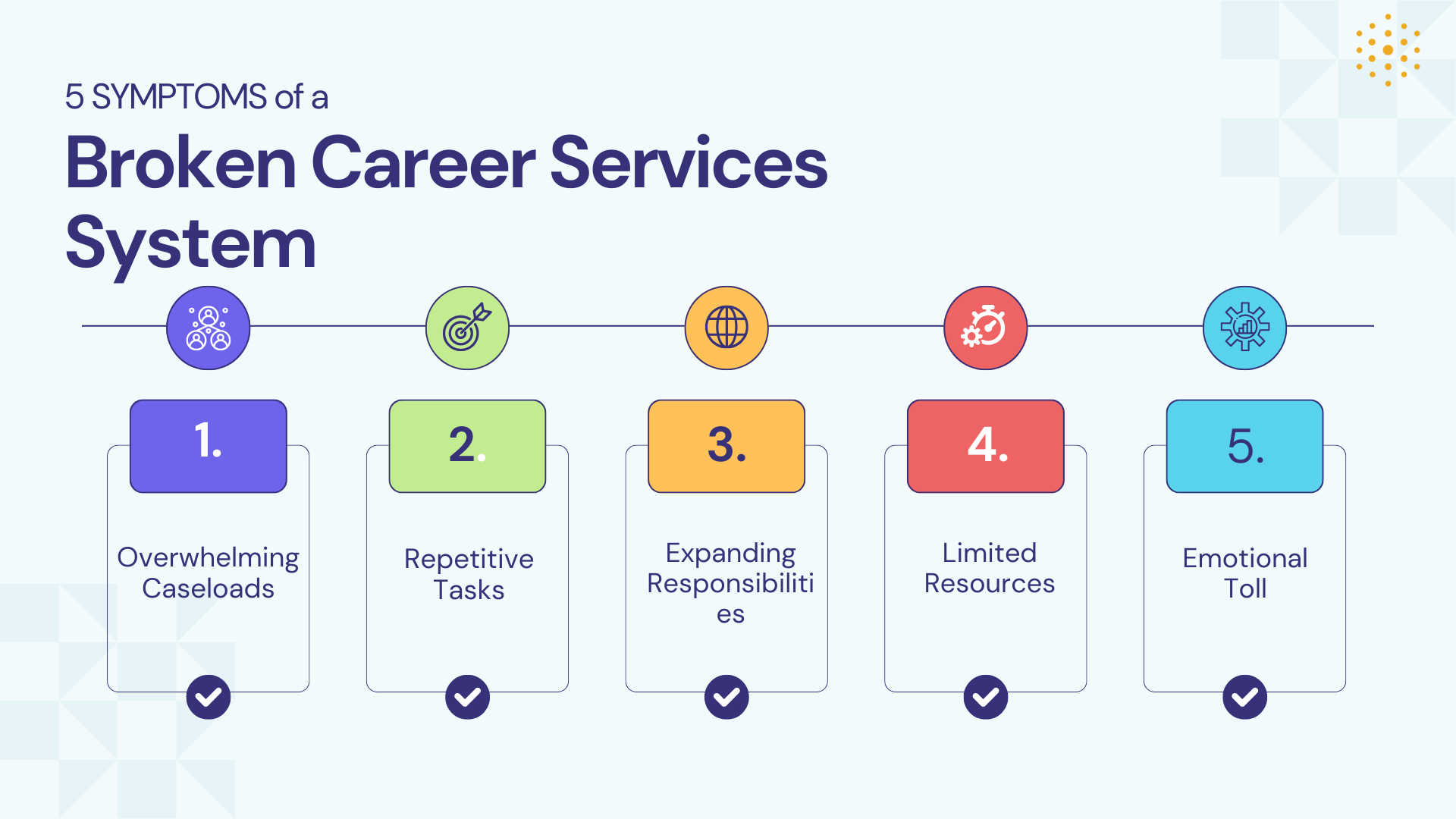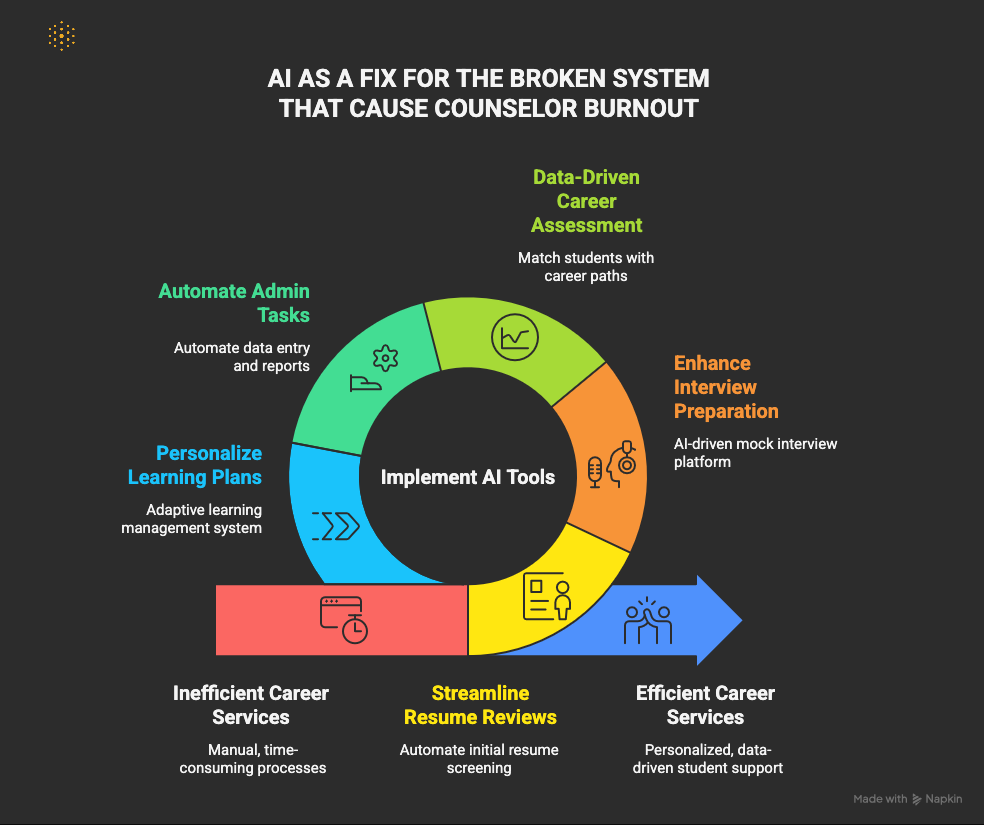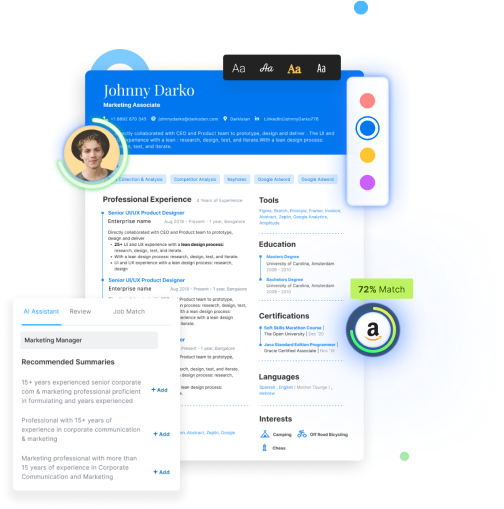How can career counselors address burnout rooted in outdated, manual workflows?
Use AI to automate resume reviews, interview prep, assessments, and routine admin, removing bottlenecks from high-volume tasks. Refocus saved time on strategic coaching and partnerships by treating burnout as a process issue and scaling workflows.
You became a career counselor to change lives. But if you’re spending your days drowning in paperwork and battling repetitive tasks, you’re likely feeling more burned out than inspired.
If your passion has been overshadowed by exhaustion and a sense of being overwhelmed, you're not alone.
A staggering 53% of college faculty, including counselors, is on the brink of resignation due to burnout.
While it's easy to point fingers at staffing numbers, the real culprit is often hidden in plain sight: the outdated systems and inefficient workflows we rely on every day.
Before we dive into solutions, let’s reframe the problem. This is a crisis of process, not just personnel.
The Symptoms of a Broken System
The American School Counselor Association recommends a student-counselor ratio of 250 to 1.
The reality? 1,583:1 - the median ratio of students to career services staff across the US, as per Forbes.
That's right! More than 6 times the recommended ratio. The horrors!
These numbers don't just mean you're busy; they mean the manual systems you use are pushed past their breaking point. This systemic strain manifests in several ways:
Overwhelming Caseloads Magnified by Manual Processes
On paper, your advisor-to-student ratio might seem manageable. In practice, it feels impossible.
This disconnect happens when every single interaction - from the first resume draft to the final mock interview, requires a significant manual effort.
The core issue isn't the number of students; it's the lack of a scalable system. When a process can't be scaled, it creates bottlenecks that bring productivity to a halt.
This was the exact challenge faced by the career services team at Tech Elevator, who found themselves completely "overwhelmed" by the high volume of student resumes they had to review manually.
This single manual task became a major bottleneck in their entire student experience, proving that even a dedicated team can be swamped when the system doesn't support their efforts.
The Drain of Repetitive, Time-Consuming Tasks
How many hours a week does your team spend on the same basic tasks? Correcting resume formats, answering repetitive questions, scheduling initial intake sessions.
These routine activities are the biggest culprits behind inefficiency, slowly draining your team's creative energy and job satisfaction.
Advisors are passionate about guiding students toward their dream careers, not about fixing margins and bullet points. Yet, broken systems force them to become editors instead of coaches.
At Shawnee State University, advisors found themselves spending the majority of their valuable appointment time on "basic formatting and structure" instead of the "higher-impact coaching" that truly makes a difference.
When the manual review process at Tech Elevator took weeks to complete, it wasn’t just inefficient, it was a systemic barrier preventing skilled professionals from doing their best work.

Expanding Responsibilities on a Foundation of Inefficiency
The role of a career services professional has exploded in recent years.
You’re no longer just a resume checker. You're an event planner, an employer liaison, a data analyst, and a marketing specialist.
Your responsibilities have grown, but have your foundational processes evolved to support them?
For most, the answer is no.
New duties are simply piled on top of the same old manual workflows.
You're asked to build robust employer partnerships while still being bogged down by a clunky, time-consuming resume review system.
This forces you into a constant state of compromise, where you can't give any single task the attention it deserves.
The system isn't adapting to your growing duties, leaving you to stretch thinner and thinner.
The Myth of Limited Resources vs. The Reality of Wasted Time
"We need to do more with less." It's a common refrain in higher education, but it frames the problem incorrectly.
The issue is rarely a true lack of resources; it's a systemic failure to use the most valuable resource of all time effectively.
Inefficient, manual systems are thieves of time. Every hour spent on a task that could be automated is an hour that can't be reinvested in personalized student coaching, strategic planning, or professional development.
Think about what your team could achieve with reclaimed time.
The Compounding Emotional Toll of Broken Systems
The emotional weight of supporting students through one of the most stressful periods of their lives is significant.
But the burnout so many advisors feel is compounded by a secondary stressor: fighting a losing battle against their own internal systems.
It's draining to know you could be providing better, faster, more impactful support if only the processes weren't holding you back.
This is especially true for teams like the one at MUST Ministries, which needed 24/7 accessible career support to help clients facing significant employment barriers.
Burnout caused by broken systems doesn't just impact your well-being. It directly affects the quality of guidance you provide, the success of your students, and the overall effectiveness of your institution.
Let's explore how AI can help you fix these systemic challenges and reignite your passion.

Enter AI: Practical Steps to Reclaim Your Time & Energy
1. Streamline Resume Reviews
The traditional, one-by-one resume review process is a classic workflow bottleneck. AI-powered tools can break this logjam by pre-screening resumes, identifying key skills, and providing tailored feedback.
This fixes the system, allowing you to focus your expertise on nuanced, strategic advice during student meetings.
At Rasmussen University, students and alumni created over 3,000 resumes in just the first nine months with Hiration, demonstrating students are ready and willing to engage with tools that give them immediate value.
This was also seen at Tech Elevator, where the team achieved 90% faster resume reviews, cutting down a process that took weeks to just one or two days. This allowed for a 100% shift in staff focus from formatting to strategic guidance.
Pro-tip: Start by automating 50% of your resume reviews and scale as you feel more comfortable with AI's capabilities.
This allows you to focus on providing more nuanced, personalized advice during student meetings.
Read more: Hiration vs VMock - What’s Right for your Career Center?
2. Enhance Interview Preparation
Offering scalable, effective interview prep is a systemic challenge. AI interview platforms solve this by allowing students to practice common questions and receive instant feedback on their own time.
You can then use your sessions to address advanced strategies, fixing the inefficiency of repetitive, introductory-level coaching.
At Shawnee State University, advisors saved over 40 hours in preparation time by using automated mock interviews alone, which helped contribute to a 6% increase in overall career services appointments.
During a pilot, students also completed 30 asynchronous mock interviews and created 127 foundational resume drafts.
Read more: Is Hiration a Better Big Interview Alternative for Career Centers?
3. Data-Driven Career Assessment
Leverage career assessment tools like Pymetrics or CareerExplorer. These platforms create an efficient, data-driven system for the initial stages of career exploration.
By using sophisticated algorithms to match students with potential career paths, they provide a solid foundation, allowing you to have deeper, more impactful conversations from the start.
Pro-tip: Create a more personalized experience by using these assessments for tailoring your advice to each unique candidate.
4. Automate Administrative Tasks
Nothing screams "broken process" louder than manual data entry and report generation.
Implement AI-driven tools like Zapier or IFTTT to automate these routine administrative tasks.
Fixing these backend systems frees up significant time for what you do best: interacting with students.
Pro-tip: Automate email follow-ups post career fairs to free yourself for more impactful work.
5. Personalize Learning Plans
Creating and tracking personalized development plans for hundreds of students is manually impossible.
Use AI-powered learning management systems like Knewton or Carnegie Learning to build an automated, adaptive system.
These platforms adjust to each student's progress, allowing you to monitor their growth and provide targeted guidance efficiently.

Conclusion
Burnout is a systemic problem that demands a systemic solution. By integrating AI into your workflow, you’re not just managing your workload; you’re fixing the broken processes that cause burnout in the first place.
Imagine a system where students get instant, AI-powered feedback on their resumes, freeing up advisors to focus on strategy and coaching.
Hiration is designed to absorb the high-volume, low-impact work, allowing your team to shift its focus entirely. This systemic change leads to incredible results:
- A 100% shift in focus from formatting to strategic guidance, as seen at Tech Elevator.
- A 93% increase in job placements and a 147% increase in combined wages, as achieved by MUST Ministries.
Are you ready to rekindle your passion by building a better system? The future of career services is here, and it starts with you.
Trusted by institutions like NYU Stern and University of Arizona, Hiration’s platform is designed to help you save 100+ staff days per year and increase student engagement by up to 5x.
Try it with a free pilot, no commitment needed. Schedule a live demo and experience how a better system can transform your career center.
Choose a suitable day and time to kickstart a new era of career services!
Frequently Asked Questions
-
What are the signs that counselor burnout is a systems problem?
You experience overwhelming caseloads, repetitive manual tasks, expanding responsibilities without evolved processes, wasted time, and a compounding emotional toll. These signal broken workflows rather than staffing alone.
-
How do overwhelming caseloads indicate a broken process?
The core issue isn't the number of students; it's the lack of a scalable system. When a process can't be scaled, it creates bottlenecks that bring productivity to a halt.
-
How do repetitive tasks contribute to counselor burnout?
Repetitive tasks drain your time and reduce your job satisfaction. These routine activities are the biggest culprits behind inefficiency and force them to become editors instead of coaches.
-
What is the recommended student-counselor ratio vs the reality?
The recommended student-counselor ratio is 250 to 1, but the median reality across the US is 1,583:1.
-
How can AI streamline resume reviews?
Use AI to pre-screen resumes and deliver tailored feedback so you focus on strategic advising. Students created over 3,000 resumes, and teams achieved 90% faster resume reviews with a 100% shift from formatting to strategic guidance.
-
How can AI improve interview preparation?
AI interview platforms let students practice questions and get instant feedback, so you focus on advanced strategies. Advisors saved over 40 hours and saw a 6% increase in appointments, with 30 asynchronous mock interviews and 127 foundational resume drafts.
-
What administrative tasks should you automate to reclaim time?
Automate manual data entry, report generation, and email follow-ups after career fairs using AI-driven tools. Fixing these backend systems frees up significant time for interacting with students.
-
How do data-driven career assessments support your counseling?
Use platforms like Pymetrics or CareerExplorer to match students with potential career paths through algorithms. They create an efficient, data-driven system for the initial stages of career exploration and enable deeper conversations from the start.
-
What is the biggest misconception about limited resources in career services?
Believing you must do more with less masks a systems issue. The problem is a systemic failure to use time effectively, since inefficient, manual systems are thieves of time.
-
What outcomes can you expect from fixing broken systems with AI?
You redirect effort to strategic guidance and see stronger outcomes. Reported results include a 93% increase in job placements, a 147% increase in combined wages, saving 100+ staff days per year, and increasing engagement by up to 5x.



